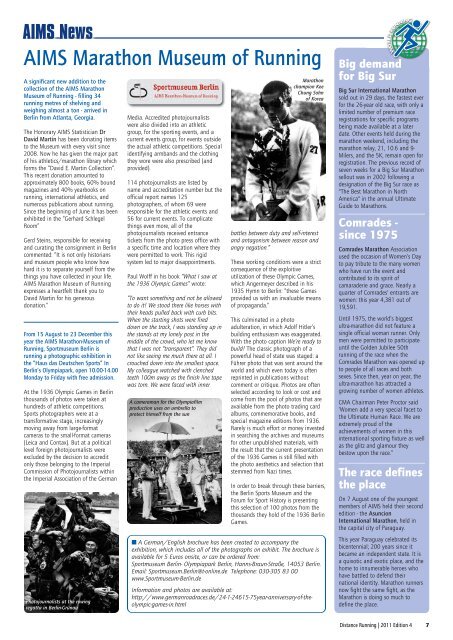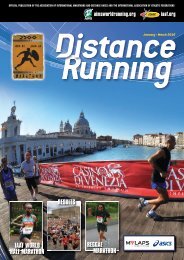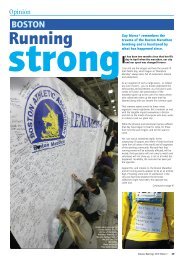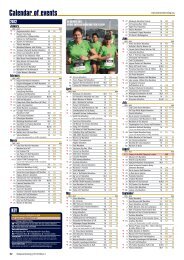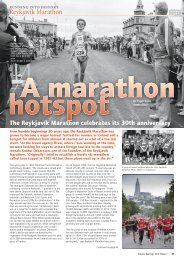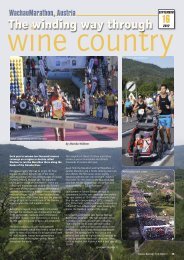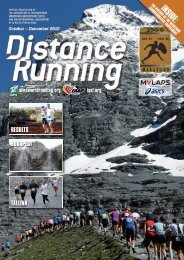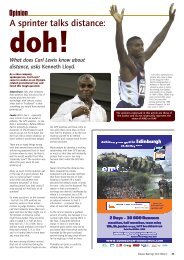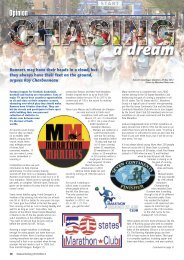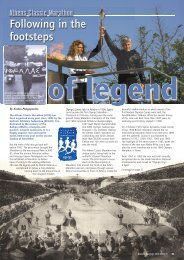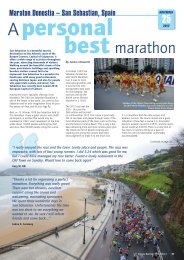Download pdf - Distance Running magazine
Download pdf - Distance Running magazine
Download pdf - Distance Running magazine
Create successful ePaper yourself
Turn your PDF publications into a flip-book with our unique Google optimized e-Paper software.
AIMS News<br />
AIMS Marathon Museum of <strong>Running</strong><br />
A significant new addition to the<br />
collection of the AIMS Marathon<br />
Museum of <strong>Running</strong> - filling 34<br />
running metres of shelving and<br />
weighing almost a ton - arrived in<br />
Berlin from Atlanta, Georgia.<br />
The Honorary AIMS Statistician Dr<br />
David Martin has been donating items<br />
to the Museum with every visit since<br />
2008. Now he has given the major part<br />
of his athletics/marathon library which<br />
forms the “David E. Martin Collection”.<br />
This recent donation amounted to<br />
approximately 800 books, 60% bound<br />
<strong>magazine</strong>s and 40% yearbooks on<br />
running, international athletics, and<br />
numerous publications about running.<br />
Since the beginning of June it has been<br />
exhibited in the “Gerhard Schlegel<br />
Room”<br />
Gerd Steins, responsible for receiving<br />
and curating the consignment in Berlin<br />
commented: “It is not only historians<br />
and museum people who know how<br />
hard it is to separate yourself from the<br />
things you have collected in your life.<br />
AIMS Marathon Museum of <strong>Running</strong><br />
expresses a heartfelt thank you to<br />
David Martin for his generous<br />
donation.”<br />
From 15 August to 23 December this<br />
year the AIMS Marathon-Museum of<br />
<strong>Running</strong>, Sportmuseum Berlin is<br />
running a photographic exhibition in<br />
the “Haus das Deutschen Sports” In<br />
Berlin’s Olympiapark, open 10.00-14.00<br />
Monday to Friday with free admission.<br />
At the 1936 Olympic Games in Berlin<br />
thousands of photos were taken at<br />
hundreds of athletic competitions.<br />
Sports photographers were at a<br />
transformative stage, increasingly<br />
moving away from large-format<br />
cameras to the small-format cameras<br />
(Leica and Contax). But at a political<br />
level foreign photojournalists were<br />
excluded by the decision to accredit<br />
only those belonging to the Imperial<br />
Commission of Photojournalists within<br />
the Imperial Association of the German<br />
Photojournalists at the rowing<br />
regatta in Berlin-Grünau<br />
Media. Accredited photojournalists<br />
were also divided into an athletic<br />
group, for the sporting events, and a<br />
current events group, for events outside<br />
the actual athletic competitions. Special<br />
identifying armbands and the clothing<br />
they wore were also prescribed (and<br />
provided).<br />
114 photojournalists are listed by<br />
name and accreditation number but the<br />
official report names 125<br />
photographers, of whom 69 were<br />
responsible for the athletic events and<br />
56 for current events. To complicate<br />
things even more, all of the<br />
photojournalists received entrance<br />
tickets from the photo press office with<br />
a specific time and location where they<br />
were permitted to work. This rigid<br />
system led to major disappointments.<br />
Paul Wolff in his book “What I saw at<br />
the 1936 Olympic Games” wrote:<br />
“To want something and not be allowed<br />
to do it! We stood there like horses with<br />
their heads pulled back with curb bits.<br />
When the starting shots were fired<br />
down on the track, I was standing up in<br />
the stands at my lonely post in the<br />
middle of the crowd, who let me know<br />
that I was not “transparent”. They did<br />
not like seeing me much there at all. I<br />
crouched down into the smallest space.<br />
My colleague watched with clenched<br />
teeth 100m away as the finish line tape<br />
was torn. We were faced with inner<br />
A cameraman for the Olympiafilm<br />
production uses an umbrella to<br />
protect himself from the sun<br />
Marathon<br />
champion Kee<br />
Chung Sohn<br />
of Korea<br />
battles between duty and self-interest<br />
and antagonism between reason and<br />
angry negation.”<br />
These working conditions were a strict<br />
consequence of the exploitive<br />
utilization of these Olympic Games,<br />
which Angermeyer described in his<br />
1935 Hymn to Berlin: “these Games<br />
provided us with an invaluable means<br />
of propaganda.”<br />
This culminated in a photo<br />
adulteration, in which Adolf Hitler’s<br />
building enthusiasm was exaggerated.<br />
With the photo caption We’re ready to<br />
build! The classic photograph of a<br />
powerful head of state was staged: a<br />
Führer photo that was sent around the<br />
world and which even today is often<br />
reprinted in publications without<br />
comment or critique. Photos are often<br />
selected according to look or cost and<br />
come from the pool of photos that are<br />
available from the photo trading card<br />
albums, commemorative books, and<br />
special <strong>magazine</strong> editions from 1936.<br />
Rarely is much effort or money invested<br />
in searching the archives and museums<br />
for other unpublished materials, with<br />
the result that the current presentation<br />
of the 1936 Games is still filled with<br />
the photo aesthetics and selection that<br />
stemmed from Nazi times.<br />
In order to break through these barriers,<br />
the Berlin Sports Museum and the<br />
Forum for Sport History is presenting<br />
this selection of 100 photos from the<br />
thousands they hold of the 1936 Berlin<br />
Games.<br />
■ A German/English brochure has been created to accompany the<br />
exhibition, which includes all of the photographs on exhibit. The brochure is<br />
available for 5 Euros onsite, or can be ordered from:<br />
Sportmuseum Berlin- Olympiapark Berlin, Hanns-Braun-Straße, 14053 Berlin.<br />
Email: Sportmuseum.Berlin@t-online.de Telephone: 030-305 83 00<br />
www.Sportmuseum-Berlin.de<br />
Information and photos are available at:<br />
http://www.germanroadraces.de/24-1-24615-75year-anniversary-of-theolympic-games-in.html<br />
Big demand<br />
for Big Sur<br />
Big Sur International Marathon<br />
sold out in 29 days, the fastest ever<br />
for the 26-year old race, with only a<br />
limited number of premium race<br />
registrations for specific programs<br />
being made available at a later<br />
date. Other events held during the<br />
marathon weekend, including the<br />
marathon relay, 21, 10.6 and 9-<br />
Milers, and the 5K, remain open for<br />
registration. The previous record of<br />
seven weeks for a Big Sur Marathon<br />
sellout was in 2002 following a<br />
designation of the Big Sur race as<br />
"The Best Marathon in North<br />
America" in the annual Ultimate<br />
Guide to Marathons.<br />
Comrades -<br />
since 1975<br />
Comrades Marathon Association<br />
used the occasion of Women’s Day<br />
to pay tribute to the many women<br />
who have run the event and<br />
contributed to its spirit of<br />
camaraderie and grace. Nearly a<br />
quarter of Comrades' entrants are<br />
women: this year 4,381 out of<br />
19,591.<br />
Until 1975, the world’s biggest<br />
ultra-marathon did not feature a<br />
single official woman runner. Only<br />
men were permitted to participate<br />
until the Golden Jubilee 50th<br />
running of the race when the<br />
Comrades Marathon was opened up<br />
to people of all races and both<br />
sexes. Since then, year on year, the<br />
ultra-marathon has attracted a<br />
growing number of women athletes.<br />
CMA Chairman Peter Proctor said<br />
‘Women add a very special facet to<br />
the Ultimate Human Race. We are<br />
extremely proud of the<br />
achievements of women in this<br />
international sporting fixture as well<br />
as the glitz and glamour they<br />
bestow upon the race.”<br />
The race defines<br />
the place<br />
On 7 August one of the youngest<br />
members of AIMS held their second<br />
edition - the Asuncion<br />
International Marathon, held in<br />
the capital city of Paraguay.<br />
This year Paraguay celebrated its<br />
bicentennial; 200 years since it<br />
became an independent state. It is<br />
a quixotic and exotic place, and the<br />
home to innumerable heroes who<br />
have battled to defend their<br />
national identity. Marathon runners<br />
now fight the same fight, as the<br />
Marathon is doing so much to<br />
define the place.<br />
<strong>Distance</strong> <strong>Running</strong> | 2011 Edition 4 7


